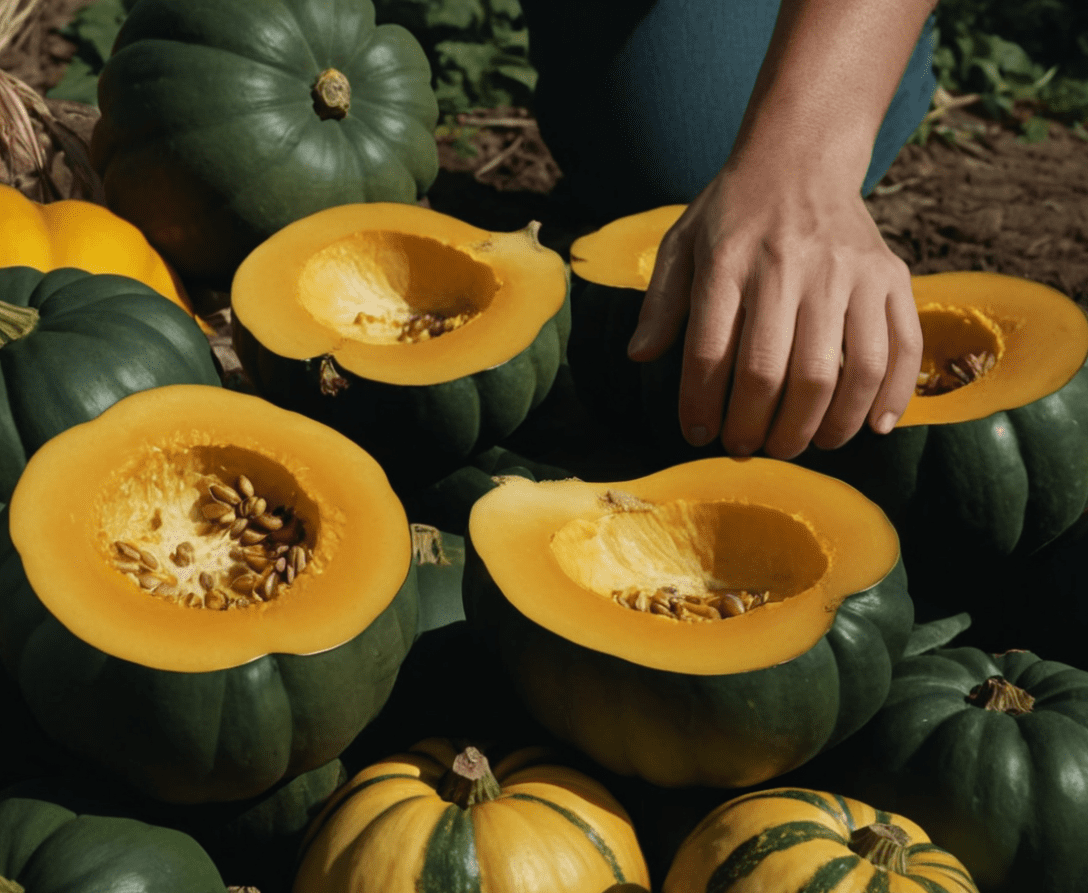
Acorn squash is a delicious, nutrient-rich vegetable perfect for your fall and winter meals. But knowing when to pick acorn squash can be tricky if you’re unfamiliar with the signs of ripeness. In this guide, we’ll explore everything you need to know about acorn squash, from understanding it to harvesting and storing it correctly. By the end, you’ll be confident in knowing when your acorn squash is ready to be picked, ensuring you get the best flavor and storage life from your harvest.
What is Acorn Squash?
Table of Contents
ToggleAcorn squash is a type of winter squash easily recognizable by its distinctive ribbed skin and acorn-like shape. Unlike summer squash, typically harvested when tender and immature, winter squash like acorn can mature fully on the vine, developing a hard rind and rich flavor. Acorn squash is prized for its nutty flavor and versatility in the kitchen, making it a staple in many households during the cooler months.
Understanding Winter vs. Summer Squash
Before diving into the specifics of acorn squash, it’s essential to understand the difference between winter and summer squash. Summer squash, such as zucchini, is harvested when the rind is soft and the seeds are undeveloped. This type of squash is usually consumed shortly after harvesting due to its shorter shelf life.
Winter squash, on the other hand, including acorn squash, is left to mature on the vine until the rind hardens and the seeds fully develop. This process enhances the flavor and allows the squash to be stored for several months, making it a reliable food source during the winter.
When to Harvest Acorn Squash
So, how do you know when your acorn squash is ready to be picked? There are a few key indicators that signal it’s time to harvest.
Identifying Ripeness
- Color Change: One of the first signs that your acorn squash is ripe is a change in color. Typically, a ripe acorn squash will be dark green, almost black, with a noticeable orange spot where it has been resting on the ground. This color contrast indicates that your squash is ready for harvest.
- Rind Hardness: Another crucial factor in determining ripeness is the hardness of the rind. A mature acorn squash will have a tough, thick skin that cannot be easily pierced with a fingernail. If the rind is still soft, give it more time to mature.
- Stem Condition: The stem condition is also a telltale sign of ripeness. When the stem starts to wither and turns brown, it strongly indicates that the squash is fully mature. A green stem usually means the squash needs more time on the vine.
Harvest Timing
- Days to Harvest: Acorn squash generally takes 80 to 100 days to mature from planting. This timeline can vary slightly depending on the growing conditions and variety, so it’s always a good idea to keep an eye on the specific growth of your plants.
- Frost Considerations: Harvesting your acorn squash before the first frost is crucial. Frost can damage the squash, leading to a shorter storage life and affecting the flavor. If a frost is imminent and your squash isn’t quite ready, consider covering your plants to extend their growing season just a bit longer.
How to Harvest Acorn Squash
It’s time to harvest once you’ve determined that your acorn squash is ripe. Here’s how to do it properly:
- Use Sharp Pruning Shears: To avoid damaging the plant or the squash, use sharp pruning shears or a knife to cut the squash from the vine. Leave a few inches of stem attached to the squash, as this will help extend its shelf life.
- Handle Gently: Acorn squash has a hard rind, but it can still be damaged if handled roughly. Be gentle to avoid bruising the squash, which can lead to rotting during storage.
- Cure Your Squash: After harvesting, allow your squash to cure in a warm, dry place for about 10 days. This curing process helps harden the rind further and improves the storage life of the squash.
Storing Acorn Squash
Proper storage is key to enjoying your acorn squash well into winter. Here’s how to store it effectively:
Post-Harvest Tips
- Avoid Frost-Damaged Squash: As mentioned earlier, frost-damaged squash will not store well. Be sure to harvest all your squash before frost hits and discard any that show signs of damage.
- Allow the Rind to Harden: After harvesting, letting the squash sit in a warm area for about 10 days is beneficial. This additional time allows the rind to harden completely, which is crucial for long-term storage.
Storage Conditions
- Cool, Dry Environment: Store your acorn squash in a cool (50-55°F), dry, and well-ventilated area. A basement or root cellar is ideal. Proper ventilation prevents moisture buildup, which can cause rot.
- Keep Them Off the Ground: It’s a good idea to store your squash on a shelf or pallet. This improves air circulation around the squash and reduces the risk of rotting.
- Check Regularly: Periodically check your stored squash for any signs of decay. Remove any squash that show signs of spoilage to prevent it from affecting the others.
Wrapping Up
Growing and harvesting acorn squash can be a rewarding experience, especially when you know the right time to pick them. By understanding the signs of ripeness and following proper harvesting and storage practices, you can enjoy the sweet, nutty flavor of acorn squash all winter long.
Whether you’re a seasoned gardener or trying to grow acorn squash for the first time, these tips will help ensure a successful harvest. So go ahead, get your hands dirty, and enjoy the fruits of your labor with delicious, home-grown acorn squash.
Call to Action
If you found this guide helpful, don’t forget to sign up for our newsletter for more gardening tips and tricks. And if you’re looking to expand your gardening knowledge.




























